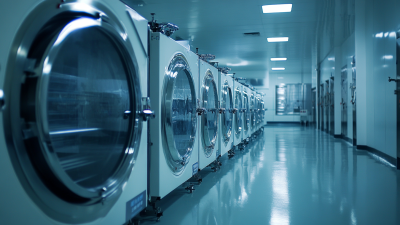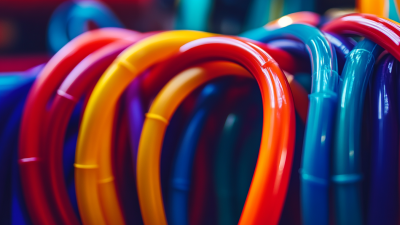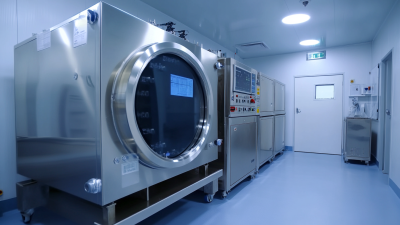- Home
- Products
- Services
- Product concept development
- Engineering
- Design for manufacturability
- Regulatory services
Read more - Material selection and formulation
- Prototyping
- Testing and validation
Read more - Production process development
- Custom tooling
- Manufacturing
- Finishing operations
- Assembly
- Packaging
- Private labeling
- Sterilization
Read more
- Resources
- Careers
- Search
Exploring Innovative Autoclave Sterilization Methods for Enhanced Safety and Efficiency
In recent years, the healthcare and pharmaceutical industries have increasingly prioritized the need for enhanced safety and efficiency in sterilization processes. Autoclave sterilization, recognized for its ability to effectively eliminate pathogens through high-pressure steam, continues to be a cornerstone of sterile production and infection control. According to a report by Research and Markets, the global sterilization services market is projected to reach USD 6.73 billion by 2026, growing at a CAGR of 11.6% from 2021. This growth underscores the importance of adopting innovative autoclave sterilization methods that not only maximize microbial kill rates but also minimize energy consumption and processing times. By exploring cutting-edge advancements in this area, healthcare facilities can significantly optimize their sterilization protocols while ensuring compliance with regulatory standards, ultimately leading to safer patient outcomes and improved operational efficiency.

Innovative Autoclave Designs: Revolutionizing Sterilization Efficiency
The evolution of autoclave designs is set to dramatically enhance sterilization efficiency, addressing the increasing demands for safety in healthcare and laboratory settings. With innovations in technology, modern autoclaves are becoming more user-friendly, reliable, and faster, allowing for quick turnaround times without sacrificing effectiveness. These new designs incorporate advanced features such as automated cycles, real-time monitoring, and energy-efficient operations, helping facilities streamline their sterilization processes while ensuring compliance with stringent safety regulations.
As the sterilization equipment market in India is projected to reach approximately USD 790 million by 2030, the push for innovative autoclave designs reflects a broader trend towards improving infection control protocols. Hospitals and laboratories are increasingly adopting state-of-the-art sterilization solutions to safeguard public health and enhance operational efficiency. With innovations that promise to revolutionize sterilization practices, the future looks bright for both manufacturers and users, signaling a pivotal shift in how sterilization is approached within healthcare systems globally.
Understanding the Science Behind Autoclave Sterilization Processes
 Autoclave sterilization is a critical process widely employed in medical and laboratory settings. Understanding the science behind these sterilization processes allows us to appreciate their effectiveness and limitations. The autoclave operates primarily by utilizing high-pressure steam to eliminate microbial life, ensuring materials are safe for use. It is essential to distinguish between the sterilizing effects on solid materials and liquids, as each requires specific parameters to achieve optimal results. Solid materials tend to retain heat more effectively, leading to quicker sterilization, while liquids necessitate careful control of temperature and pressure to prevent boiling or vaporization.
Autoclave sterilization is a critical process widely employed in medical and laboratory settings. Understanding the science behind these sterilization processes allows us to appreciate their effectiveness and limitations. The autoclave operates primarily by utilizing high-pressure steam to eliminate microbial life, ensuring materials are safe for use. It is essential to distinguish between the sterilizing effects on solid materials and liquids, as each requires specific parameters to achieve optimal results. Solid materials tend to retain heat more effectively, leading to quicker sterilization, while liquids necessitate careful control of temperature and pressure to prevent boiling or vaporization.
Innovative techniques continue to emerge, refining traditional autoclave methods to enhance safety and efficiency. Studies reveal that factors such as the type of material being sterilized and the specific conditions—temperature, time, and pressure—can significantly affect the outcome of the sterilization process. Additionally, the compatibility of materials, especially in the context of new technologies like additive manufacturing, highlights the need for ongoing research into how various sterilization methods impact the physicochemical properties of biomaterials. As we explore these advancements, understanding the underlying science becomes crucial for optimizing protocols and ensuring the reliability of sterilization practices in critical healthcare applications.
Best Practices for Optimizing Autoclave Performance and Safety
Autoclaves are vital in ensuring sterile conditions in various environments, from hospitals to laboratories. To optimize autoclave performance, it is crucial to implement best practices that enhance safety and efficiency. One of the most effective strategies is to regularly calibrate and maintain the autoclave according to the manufacturer's guidelines. This includes checking the pressure, temperature, and cycle times to ensure that the equipment operates within the required parameters. Scheduled maintenance not only prolongs the life of the autoclave but also prevents the occurrence of malfunctions that could compromise sterilization processes.
 Another essential practice is to ensure proper loading of the autoclave. Overloading can hinder steam penetration, leading to inadequate sterilization. It is advisable to follow the recommended load configurations, allowing for proper airflow and steam circulation. Additionally, using appropriate packaging materials that permit steam penetration, such as approved surgical wraps or pouches, can significantly improve sterilization outcomes. Training staff on the correct usage of the autoclave and the significance of adhering to these best practices further promotes safety and efficiency in the sterilization process, ultimately contributing to better patient care and infection control.
Another essential practice is to ensure proper loading of the autoclave. Overloading can hinder steam penetration, leading to inadequate sterilization. It is advisable to follow the recommended load configurations, allowing for proper airflow and steam circulation. Additionally, using appropriate packaging materials that permit steam penetration, such as approved surgical wraps or pouches, can significantly improve sterilization outcomes. Training staff on the correct usage of the autoclave and the significance of adhering to these best practices further promotes safety and efficiency in the sterilization process, ultimately contributing to better patient care and infection control.
Emerging Technologies: Next-Gen Alternatives to Traditional Autoclaves
The medical and laboratory sectors are witnessing a transformative shift with the advent of next-generation alternatives to traditional autoclaves. These innovative sterilization methods not only improve safety but also enhance efficiency significantly. According to a report by MarketsandMarkets, the global sterilization equipment market is projected to reach $5.89 billion by 2025, with emerging technologies accounting for a significant portion of this growth. Advanced methods such as vaporized hydrogen peroxide and ozone sterilization are gaining traction, offering rapid cycles and efficacy against a wider range of pathogens, including spores and biofilms.
Additionally, the integration of digital technologies into sterilization processes exemplifies a leap towards enhanced operational efficiency. Real-time monitoring and data analytics can help optimize sterilization cycles, reducing downtime and resource waste. A Nielsen report underscores that facilities implementing these next-gen technologies have reported up to a 30% decrease in processing time while simultaneously ensuring compliance with stringent regulatory standards. By embracing these innovations, healthcare providers can not only safeguard patient health but also refine their operational workflows, marking a significant advancement in sterilization practices.
Real-World Applications: Case Studies on Autoclave Effectiveness in Healthcare
In the realm of healthcare, autoclave sterilization methods have become pivotal in ensuring the safety and efficiency of medical practices. Recent case studies highlight the effectiveness of innovative autoclaving techniques that enhance sterilization cycles, resulting in a significant reduction in healthcare-associated infections (HAIs). According to the CDC, approximately 1 in 31 hospital patients has at least one HAI on any given day, emphasizing the need for improved sterilization practices. The introduction of advanced pre-vacuum autoclaves has shown to reduce microbial loads by up to 99.9%, surpassing traditional methods and ensuring that surgical instruments remain pathogen-free.
Notably, a case study conducted at a leading hospital revealed that the implementation of a new steam sterilization protocol led to a 30% decrease in post-surgical infection rates within just six months. This not only improved patient outcomes but also reduced the overall costs associated with prolonged hospital stays and additional treatments. Furthermore, industry reports indicate that facilities adopting rapid-cycle sterilization methods, which minimize turn-around times without compromising efficacy, are witnessing enhanced operational efficiency and increased throughput. These innovative approaches to autoclave sterilization are setting new standards in the healthcare industry, reinforcing the critical role of effective sterilization in patient safety.
Exploring Innovative Autoclave Sterilization Methods for Enhanced Safety and Efficiency
| Study ID | Healthcare Facility Type | Sterilization Method | Results | Comments |
|---|---|---|---|---|
| 001 | Surgical Center | Traditional Autoclave | 99.9% Sterilization Rate | Standard method, highly effective. |
| 002 | Dental Clinic | Rapid Cycle Autoclave | 98.5% Sterilization Rate | Effective for high turnover. |
| 003 | Veterinary Hospital | Vacuum Autoclave | 97.5% Sterilization Rate | Good for porous items. |
| 004 | Research Lab | Steam Sterilization with Pre-vacuum | 99.5% Sterilization Rate | Ideal for complex loads. |
| 005 | Pharmaceutical Company | Ethylene Oxide Sterilization | 100% Sterilization Rate | Suitable for heat-sensitive devices. |
Related Posts
-

2025 Vision: The Future of Best Micro Tubing Technology and Comprehensive Procurement Insights
-

Unleashing China's Manufacturing Prowess in Autoclave Sterilization for Global Buyers
-

7 Essential Benefits of Using Peelable Heat Shrink Tubing in Your Operations
-

Exploring Innovative Alternatives to Best Ethylene Oxide Sterilization Methods
-

Exploring the Surge: How the Global Surgical Sutures Market is Expected to Reach $5.3 Billion by 2025
-

Understanding Various Types of Eto Sterilization Methods and Their Ideal Applications






